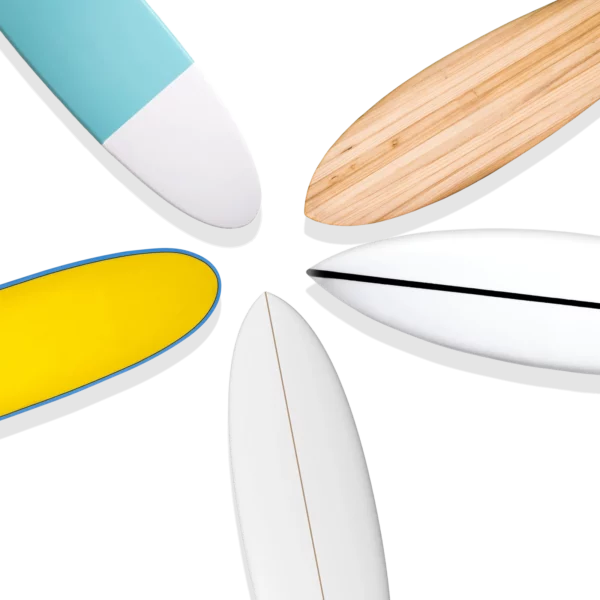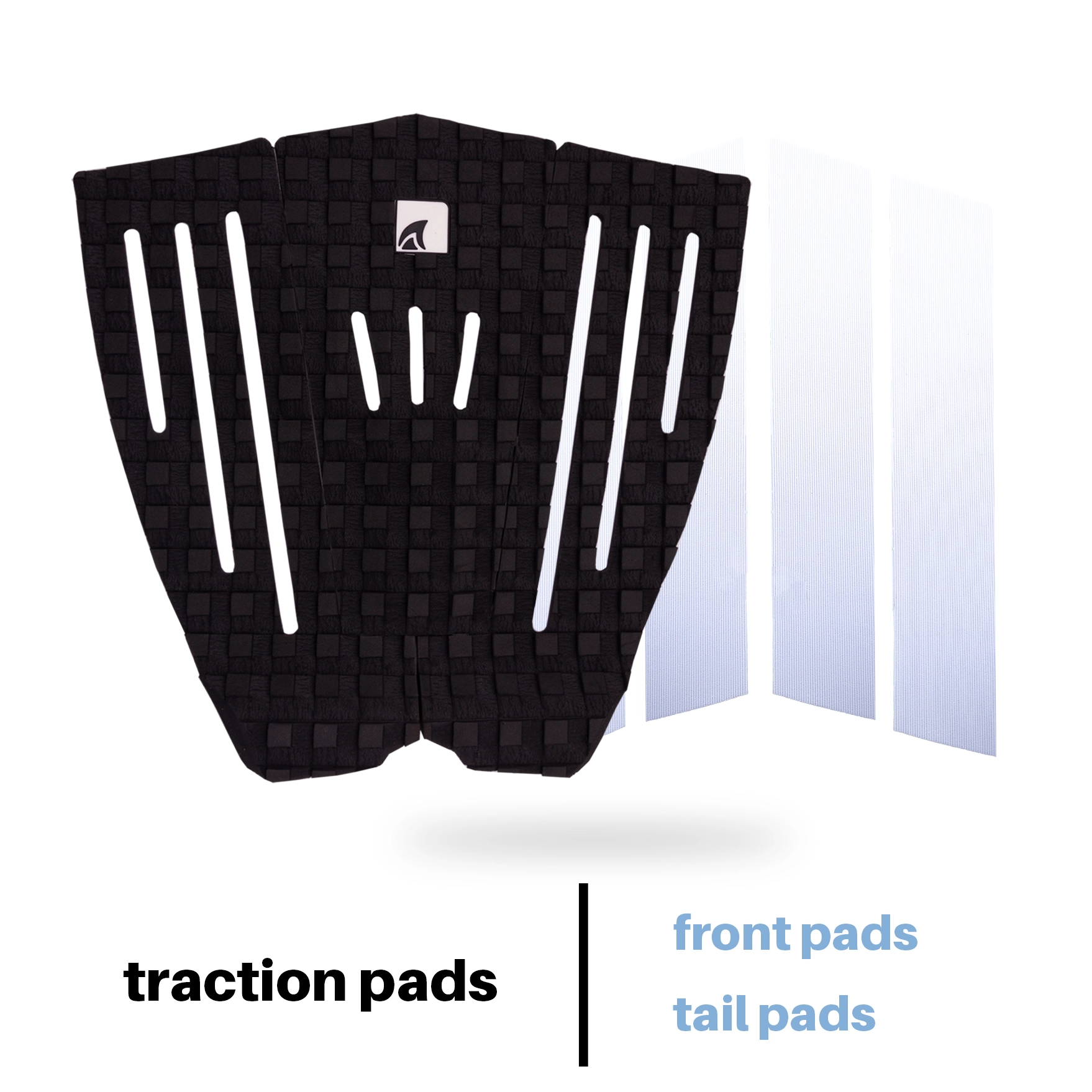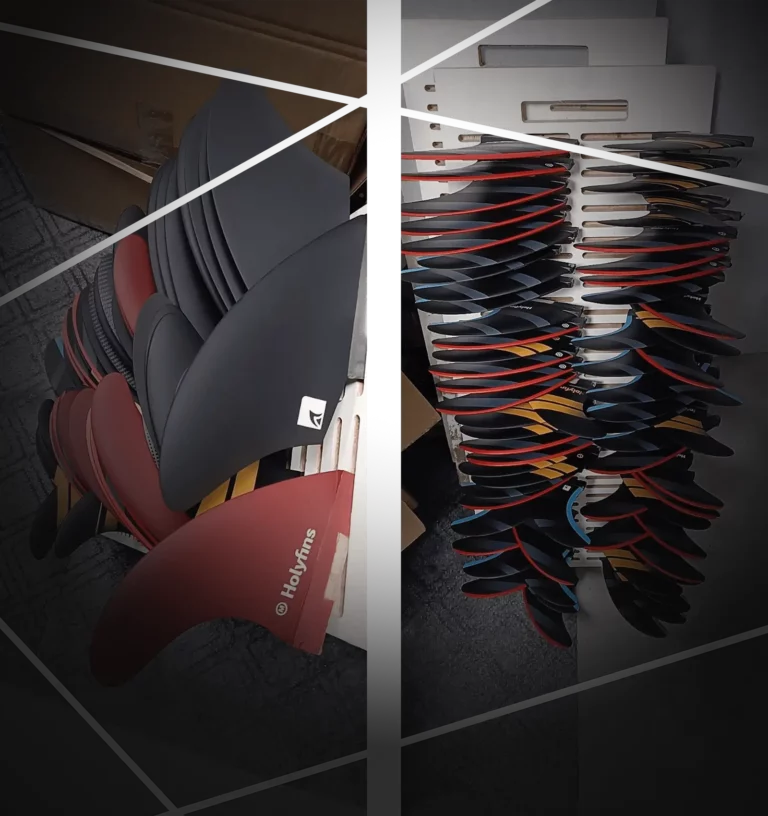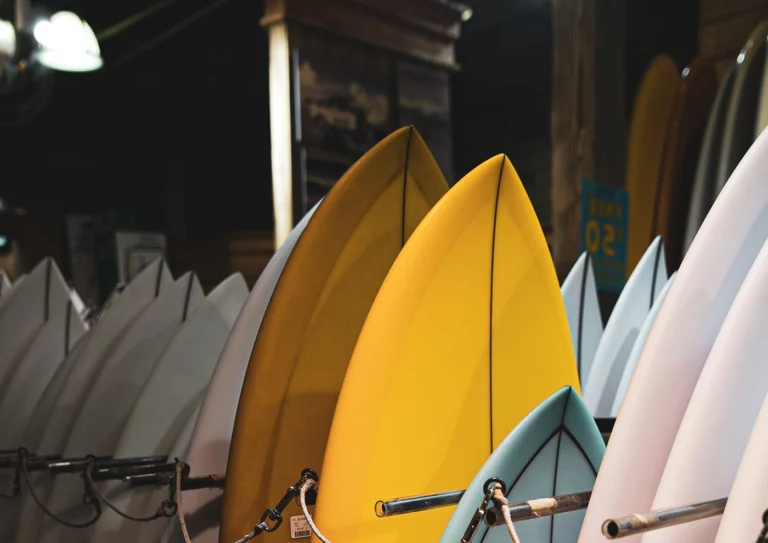Choosing the right board construction can be quite challenging if you don’t understand the materials and various construction methods that constitute surfboards. However, this variety also makes the sport unique as even two boards with identical shapes can surf vastly differently based on how they are built. So, let’s dive into understanding what surfboards are made of and how to choose the right construction for your next board.
How Surfboards are Traditionally Made
Let’s begin by understanding the traditional method of surfboard manufacturing that has been followed for roughly the last 70 years or so, with some variations over time
Basically, to craft a surfboard, you start with a bit of foam, split it into two parts, and then glue them back together with a thin strip of wood called a stringer sandwiched between them. The foam blank is then shaped to the desired specifications, and fin boxes and a leash plug are installed. Next, the whole thing is wrapped with multiple layers of fiberglass cloth, accompanied by resin, in a process known as laminating or glassing.
This method is how most surfboards have been made for a while now by shapers around the globe, but today we can see that not only are a lot more processes available, but also more materials. This provides a ton more choices to the customer than before.
Understanding Surfboard Construction: Process Variation and Material
A bit more knowledge about the process variation and materials is necessary to understand the most common surfboard constructions and help you choose yours
Blanks
Nowadays shapers opt to purchase pre-prepared blanks to save time and costs, as they come with (or without) a stringer and the rough shape of a surfboard.
These blanks are produced in a relatively limited number of factories around the globe, primarily located in the US, Australia, Portugal, Taiwan, China, and France. These factories produce blanks with various foam densities, in two foam materials: PU (polyurethane foam) and EPS (expanded polystyrene foam).
Shaping methods: Hand, CNC, Mold
As you must now have already understood, shaping is the process of transforming a rough blank into the final shape of a surfboard. There are three main methods used for shaping:
The traditional approach involves the shaper using their hands along with tools like a planer (essentially an electric sander) and sandpapers to shape the blank. However, this method is now primarily used by shapers with lower production volumes or for limited and exclusive series from bigger players, as it is more time-intensive.
A more modern method involves the use of CNC (Computer Numerical Control) machines. These machines cut the blanks into the desired shape, following a design programmed into a computer. This method significantly reduces the amount of time required for shaping, as minimal human intervention is needed. As after the CNC cutting process, only some final sanding is required to remove imperfections and refine the shape.
Additionally, foam blanks can also be shaped using molds. This process involves injecting the foam under pressure into a mold to achieve the desired shape quickly and without human hands.
Stringer
Stringers come in various sizes and can be made from different types of wood. Some surfboards may have multiple stringers, particularly on classic shapes, while others may be stringerless.
Stringers serve multiple purposes in surfboard construction. They help to control the flex of the board and to provide structural support. Basically, this thin strip of wood absorbs shocks and allows the board to flex just enough to enhance its performance and maneuverability in the water.
Layers of Fiberglass cloth
As mentioned earlier, fiberglass cloths are laminated around the shaped blank to provide structural reinforcement and get the whole thing waterproof capabilities. Shapers typically add an additional layer on the top of the board, the deck, as it experiences more pressure from directly supporting the surfer’s body.
When you see descriptions like “4x4x4” on a surfboard, it indicates the number and weight of fiberglass cloth layers used. For example, “4x4x4” means there are two layers of 4 oz cloth on the deck and one layer underneath the board. Other common glassing configurations include “6x4x4”, “6x4x6” and “6x6x6” for some longboards.
But it doesn’t stop here you can go even deeper, as there are various options to consider beyond just the number and weight of the cloth layers. You can choose different types of fiberglass cloth (e.g., e-glass, s-glass, volan…) and explore different weaving patterns or methods of layering to further customize your board construction and glassing schedule.
The Most Common Construction
What you will probably see on your local surfboard maket

Fiberglass or PU Polyurethane board and Polyester resin
The most common construction of surfboards refers to“fiberglass” or PU (polyurethane) boards combined with polyester resin. It’s worth noting that “fiberglass” is a term misused to describe this classic board construction. In reality, fiberglass is simply the cloth that is layered around the board like many other constructions.
Polyurethane boards, often abbreviated as PU boards, emerged shortly after World War II, and since 1958, they have dominated the industry. The process is as described above: you take some PU foam with a stringer, wrap it with sheets of fiberglass, and add polyester resin to bind the whole thing together.
The popularity of PU boards stems from their relative affordability and ease of production, along with their consistent and predictable performance. These boards offer a balance of characteristics making them a staple in the surfing community. However, its monopoly began to crumble as various surfboard technologies emerged over the past decade.
Epoxy or EPS foam and Epoxy resin
Considered the main competitor to PU (polyurethane) and polyester resin in the eyes of avid surfers, “epoxy” or EPS foam with epoxy resin has gained significant popularity and we can see more and more of them in the lineups around the world today.
It’s worth noting that once again surfers often refer to “epoxy” boards, thinking this time about the blank, but it’s actually the type of resin that’s laminated around the EPS foam.
The confusion arises from the fact that traditional resin cannot be used on EPS (expanded polystyrene) foams, as it can burn through it. Therefore, EPS foams are glassed with epoxy resin instead. This construction method dates back to the 1950s but was not widely used until recently due to higher costs and the more delicate nature of coating blanks with epoxy. However, as costs have decreased and shaping techniques and companies evolved, more surfboards of this type are being built every year, as some large manufacturers have adopted it as their go-to technology.
Many EPS boards are stringerless, as this construction tends to flex less than polyurethane. In exchange, carbon fiber is often used around the rail or in the middle of the shape, serving a similar function to a stringer. This construction is known for its durability and increased buoyancy compared to its PU counterpart.
Popout, Molded, Tuflite or Vacuum-Sealed boards
They all involve EPS foam pressed into a large mold to shape the board, and then it is pressed again with resin and cloth to create and laminate a complete board.
Often, for the second step, a layer of paint or a type of plastic is used with or without fiberglass cloth to glass the board and speed up the process even further.
These boards are usually among the cheapest boards on the shelves of surf shops and are typically quite durable, making them a good options for beginners and newish surfers. However, they may not perform as well as boards made using standard manufacturing methods, as they require all components (fin plugs, fiberglass sheets, leash plugs, resins…) to be combined in large molds. Another drawback is that they do not come in custom sizes as they are expensive to produce in a wide range of sizes.
Softops or Foam boards
These boards have become increasingly popular, with traditional surfing brands adopting a construction method previously associated with supermarkets and general retailers. Softops construction is closer to traditional boards than many people realize.
The foam used in softops is EPS, similar to your everyday “epoxy” boards. To maintain affordability, Polyethylene (PE) or soft Ethylene-Vinyl Acetate (EVA) is used on the deck and rails instead of a classic glassing schedule. A thin sheet of plastic is then placed under the board to provide a smooth surface.
Some higher-end soft tops may include a small layer of fiberglass cloth for added durability.
One interesting aspect of softops is that they do not use any stringer but instead utilize multiple large wood slats inside the board. These slats, usually 2 to 3 in number, run along the length of the board to prevent excessive flexing, as softops lack the outer shell made by the traditional glassing process, which helps control flex.
Softops are excellent options for beginners as they are affordable, durable, and safer in the event of meeting with your body. However, they sacrifice a lot of performance due to the additional stringers needed to hold the board together that provides an odd flex, and the limitations on shape of the rails caused by the need for the deck layer to be glued to the bottom plastic sheet.
Wooden surfboards
Wooden surfboards represent the oldest construction method on this list. While balsa wood is commonly used for wooden boards, many more exotic woods are also shaped into surfboards. They are typically crafted with a hollow core that is filled with a honeycomb-like wood structure. It’s rare now to see them in the lineups but they exist and numerous are specialized in making this kind of board.
In the late 2010s, a sandwich variant construction made by big brands became popular, involving an EPS foam core surrounded by layers of wood. Today it seems to fade away.
One interesting thing about these boards is that they feature a membrane vent to equalize air pressure inside and outside, preventing damage due to contraction and expansion caused by temperature variations or air travel.
All these surfboard constructions constitute the basis for approximately 99% of surfboards shaped and made around the world. While some unconventional constructions, such as 3D printed boards, exist, the majority of shapers and brands adhere to these construction techniques or small variations of it.
our point of view regarding board construction
Here is our rough recommendation, bear in mind that it reflects our personal opinion, but your personal preferences may vary
PU vs EPS or, as it is commonly mistaken, PU vs Epoxy or Fiberglass vs Epoxy
If you’ve read our details about the most common surfboard construction, you know that the question is in fact about boards made with PU polyurethane foam and others made from EPS expanded polystyrene blanks. Still, this question often comes to surfers’ minds. For us:
PU traditional boards are great all-around options and are the cheaper choice. However, they have their disadvantages. They may lack liveliness as they sit deeper in the water, particularly on clean small days, and they do not resist sun damage and dings as well as EPS boards.
EPS boards (“epoxy”) are also great all-around options, but we prefer them for smaller surfboards and grovelers as they float better and keep you more on top of the water. However, they can feel too buoyant and may not absorb as much shock and turbulence in powerful waves or messy surf. Nonetheless, they excel in small waves due to their higher flotation and lighter weight. We also like the fact that they are simply stronger and more resistant to yellowing.
For these reasons, we tend to favor PU on most boards unless it’s for a groveler or smaller wave board.
Regarding their glassing, we prefer a thicker or better-quality glassing schedule than what the big brands often push. For instance, a 6x4x4 schedule tends to bring much more longevity to surfboards with minimal disadvantages for the average surfer compared to a super-light 4x4x4 glassing schedule. Another excellent way to enhance durability is to use a superior cloth quality for one of the sheets, such as S-glass.
But for us, the best combination will be a PU board with an epoxy coating. While you cannot mix EPS with polyester resin, the other way around works. You can reinforce your standard 4x4x4 PU construction with epoxy resin and enjoy the best of both worlds at a slightly higher price tag.
Regarding other constructions
Popout boards: We don’t find them worth buying new as even if they are on the lower end of the spectrum price-wise, they often have the same or higher price tag than some traditionally made boards when you start to shop around. However, they make great second-hand options, especially for less experienced surfers. In the second-hand market, they tend to be significantly devalued compared to other boards, making them a rather durable and cost-effective choice.
Soft-tops: They are suitable for beginners who just want to try surfing due to their affordability. However, for those serious about the sport and not afraid of potentially hitting themselves with their board or damaging it on the first day by dropping it on a set of stairs, we strongly feel that classic “hard” boards are preferable. As soft-tops can feel, surf, and flex in unusual ways due to their construction. For more experienced surfers, we believe that a more performance-tuned soft top can be great as a beater board quickly stored in the trunk of a car, or for surfing spots where there are more rocks than water.
Wooden boards: We are not fans of the “common” sandwich wooden boards, as we feel that wood adds stiffness and weight without significant benefits. However, we’re curious about completely hollow wooden boards, although they seem more like a novelty. They would certainly make for impressive wall decorations in the house!
To quickly summarize it, for us, PU boards are our usual staple unless small waves are on the menu, and then we put the EPS boards out.
Don’t forget that there is a strong personal point of view regarding surfers and their equipment as we’re not all out there looking for the same waves and the same surfing sensations. And today, it’s amazing as more than ever, you can choose between a ton of construction variations to build the quiver you need!
We are curious about what you guys think about the various constructions around. How do you like your boards?
If you need any surfing equipment, have a look at our performant and accessible Fins , Traction Pads, and Leashes, we deliver worldwide!










Leave a Reply